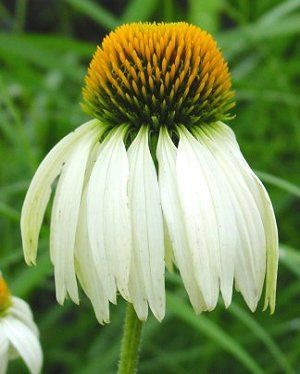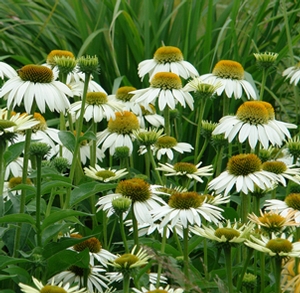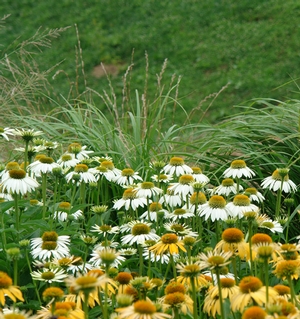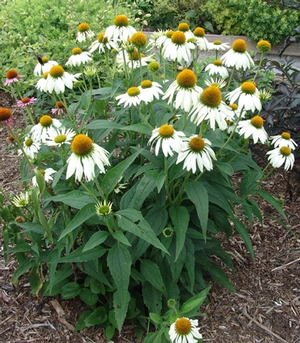Echinacea purpurea 'White Swan'
Common: purple coneflowerEchinacea purpurea 'White Swan' - 72 per flat
- Height: 2'-3'
- Spread: 12"-18"
- Spacing: 12"
- Hardiness Zone(s): 3-8


Echinacea purpurea 'White Swan' - 72 per flat



'White Swan' is not as cold hardy or vigorous as its common purple relative, but it makes up for this with its unique, beautiful, pure white flowers. A tall plant with large, dark green leaves and a large, 3-4" flower with white, broad, silky petals that surround a dark brown/bronze cone. Plants are tough and heat and drought tolerant once established. Their roots have famous medicinal qualities, they make great, long lasting, cut flowers and attract numerous butterflies and small birds.
Go easy on fertilizer, especially in production, as the resulting quick growth seems to make the plant more susceptible to disease.
Echinacea take a wide array of conditions from average dry soil to medium, well-drained soil in part shade to full sun. Plant flowers best in full sun. Low-maintenance and tolerates drought, humidity, heat, poor soil. Resistant to pest and disease but sometimes suspectible to aster yellows disease. To encourage longer bloom time, flower heads can be deadheaded but not necessary. Seedheads are a delightful source of food for birds. To propogate, divide clump in the spring every 4 years. Root cuttings are also successful. Propogation by seed does not usually come true to type.
'White Swan' is a bit more sophisticated than its pink sister. An eye catching mid summer bloomer boasting white daisies with bronze-orange cones, it begs to be included in more daring color schemes.
Ranging from Texas to New York, Echinacea purpurea can be found in moist prairies, meadows and open woods. As popular as they are in the landscape, coneflower is uncommon in the wild. They prefer full sun in fertile well-drained soil but one of the best features of Echinacea is the way it is able to tolerate drought, clay, high heat and humidity, part sun, and poor soils.
The flowers of coneflower provide multiple seasons of interest from summer while it blooms to fall and winter where the great seedheads are upright and structural. Butterflies and bees love the nectar of the flowers and goldfinches can’t help but flock to the seeds during the fall. As more cultivars of Echinacea are released on the market, we trial them in our side by side comparison trials to evaluate their merits and colors and durability against a hundred others– ‘Ruby Star’ was a clear winner.